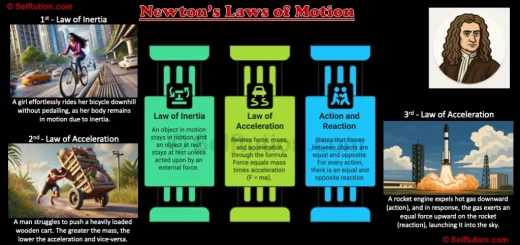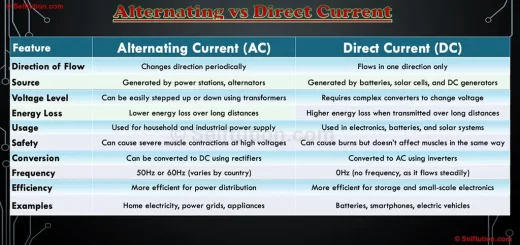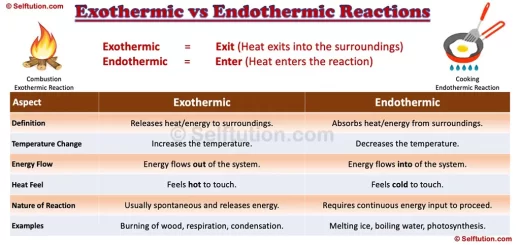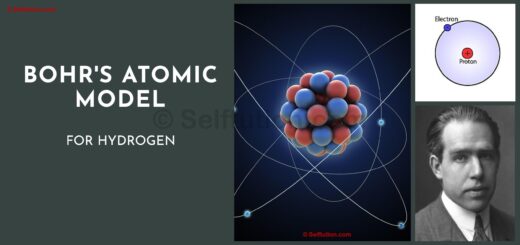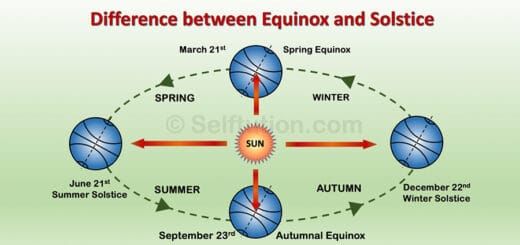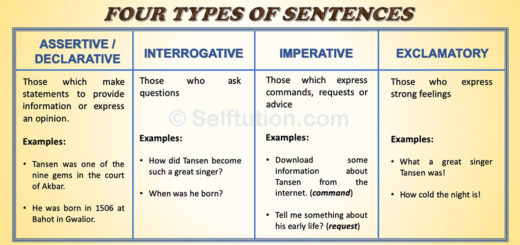Transformation or Conversion of Energy with Examples
In this post, we will learn about the transformation or conversion of energy from one form to another with examples.
As per the law of conservation of energy, the quantity of energy in this universe remains constant. It means we can neither create energy nor destroy it.
However, we can change energy from one form to another. This is known as the transformation or conversion of energy.
Let us understand the transformation or conversion of energy with the following examples –
Transformation of Energy
In a dam, we store water at a greater height, so it gains potential energy. By opening the gates of the dam, we allow this water to flow to the other side of the dam. Thus, its potential energy changes to kinetic energy, i.e., flowing water has kinetic energy.
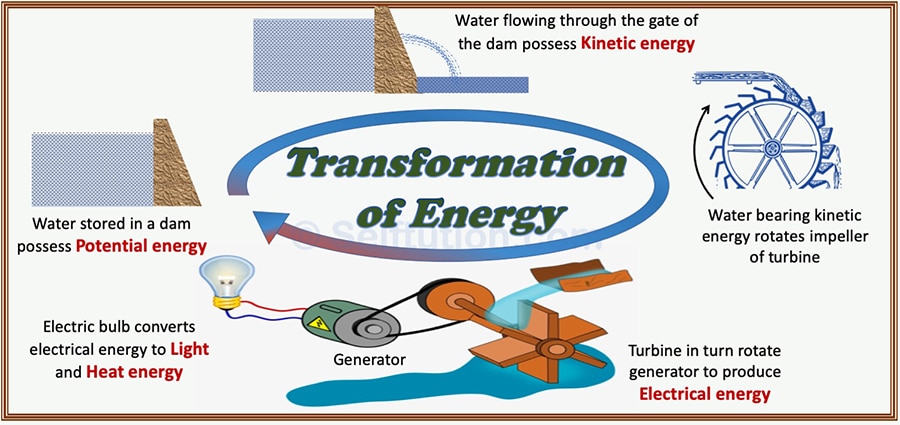
Examples of Transformation of Energy or Conversion of Energy
This water flows through pipes and rotates the big impellers of a turbine. This rotating turbine turns an engine called a generator to produce electricity or electrical energy. This electricity passes through an electric bell, an electric bulb, and an electric kettle to produce sound energy, light energy, and heat energy, respectively.
Thus, from the above examples, we conclude that we can carry out the transformation or conversion of energy from one form to another as per our requirement.
Examples of Transformation or Conversion of Electrical Energy
As stated earlier, we can convert one form of energy into another form. Examples of transformation or conversion of electrical energy are as follows:
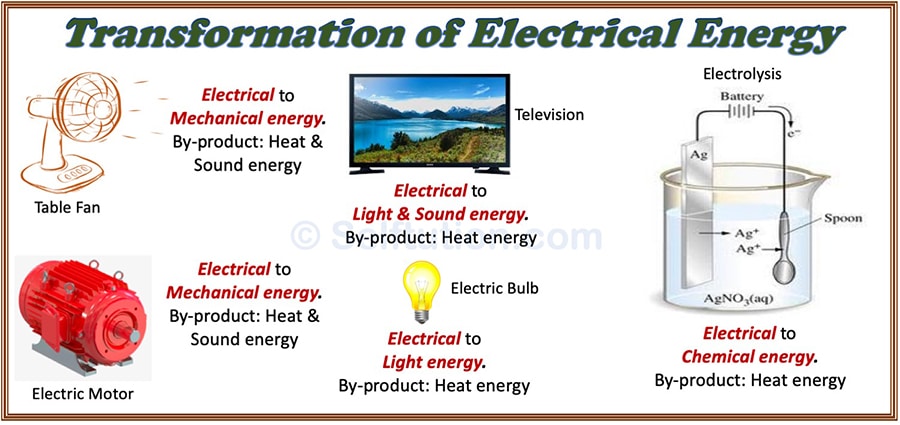
Examples of Transformation of Electrical Energy
- A table fan converts electrical energy to mechanical kinetic energy, heat, and sound energy. As heat energy and sound energy produced are much less in comparison to mechanical energy, we consider it a loss.
- When we switch on an electric bulb, a transformation or conversion of electrical energy to light and heat energy takes place. In this case, heat energy is dissipated to the surroundings as a loss.
- When we press the switch of an electric bell, electrical energy is converted to sound and heat energy. In this case, heat energy is very minor and normally ignored.
- An electric motor transforms electric energy into mechanical and heat energy. Here, most of the energy supplied to the electric motor in the form of electricity is converted to mechanical kinetic energy. For proper operation and the longer life of an electric motor, we should dissipate heat energy produced as a by-product. Some examples of the application of electric motors are washing machines, table fans, mixer grinders, pumps, compressors, etc.
- In electrolysis, we transform electrical energy into chemical energy and heat energy. Here, we dissipate heat energy to the surroundings as a loss.
- The television converts electrical energy into light, sound, and heat energy. However, the heat energy produced in this case is very less and may be ignored. But while designing an electronic system like a television calculation of heat energy is very important as it can significantly impact its design.
Examples of Transformation or Conversion of Chemical Energy
Examples of transformation or conversion of chemical energy are as follows:
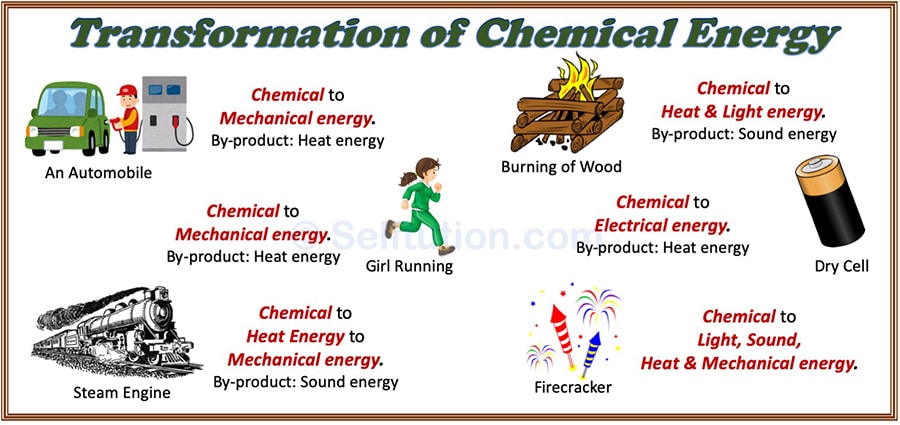
Transformation of Chemical Energy Examples
- In automobiles, a transformation or conversion of chemical energy to heat and mechanical energy takes place. For proper operation and the longer life of a vehicle, we should dissipate heat energy produced as a by-product. In order to do the same, all automobiles are provided with a cooling system.
- During the burning of wood, coal, cooking gas, or a candle, chemical energy gets converted to heat and light energy. We use heat energy for cooking and light energy for illumination purposes.
- A dry cell, voltaic cell, or any other type of battery converts chemical energy to electrical energy. This energy we use in daily life to operate many small electrical devices at home, like a torch, a mobile phone, a television remote, etc.
- When you do physical exercise or run, the chemical energy of food stored in you changes into kinetic mechanical energy.
- During the burning of a firecracker, a transformation of chemical energy to heat, light, mechanical, and sound energy takes place.
- In a steam engine, the chemical energy of the coal first changes into the heat energy of the steam. Then the heat energy of steam changes into mechanical energy, which makes the train move.
Examples of Transformation or Conversion of Mechanical Energy
Mechanical energy is of two types – potential and kinetic energy. Therefore, in order for the conversion or transformation of mechanical energy, the conversion of potential energy to kinetic energy takes place. The kinetic mechanical energy, thus produced, gets further converted to different forms of energy. Examples of transformation or conversion of mechanical energy are as follows
- In a windmill, the kinetic mechanical energy of the wind is converted to electrical energy. Although, along with the electrical energy small amount of heat and sound energy is also produced as a by-product.
- In a generator, a transformation or conversion of mechanical energy to electrical, heat, and sound energy takes place. In this case, electrical energy is the main product, whereas heat and sound are by-products.
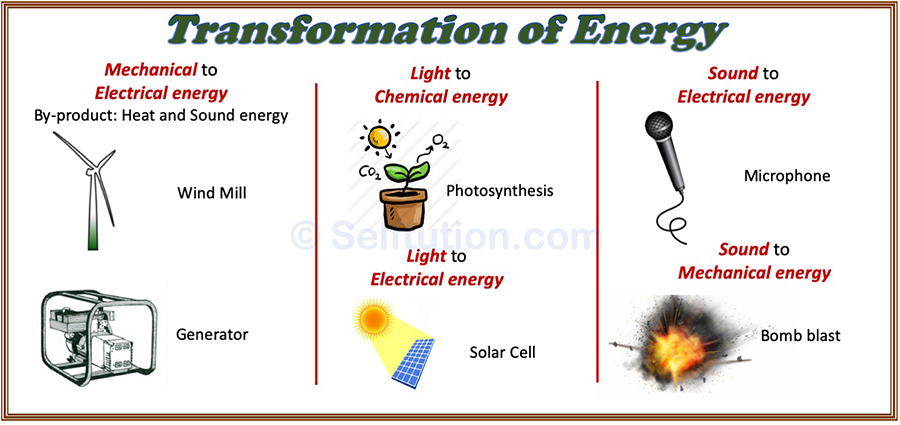
Examples of the Transformation of mechanical, light, and sound energy
Examples of Transformation or Conversion of Light Energy
- During photosynthesis, a transformation of light energy to chemical energy takes place. Green plants capture light energy from sunlight and convert it to chemical energy in the form of food. We consume this food produced by plants and convert chemical energy into mechanical energy to carry out our daily chores.
- We use solar or photovoltaic cells to transform light energy into electrical energy.
Examples of Transformation or Conversion of Sound Energy
- In a microphone, a transformation of sound energy to electrical energy takes place. To convert sound to electricity, the microphone uses magnets. Thus, we can also say that sound and magnetic energy together convert to electrical energy in a microphone.
- During a bomb blast, sound energy released travels at high speed and destroys everything that comes in contact with it. However, to destroy an object, sound energy transforms into mechanical energy.

Examples of Transformation or Conversion of Energy
You may also like…... Types of Chemical Reactions in Chemistry

